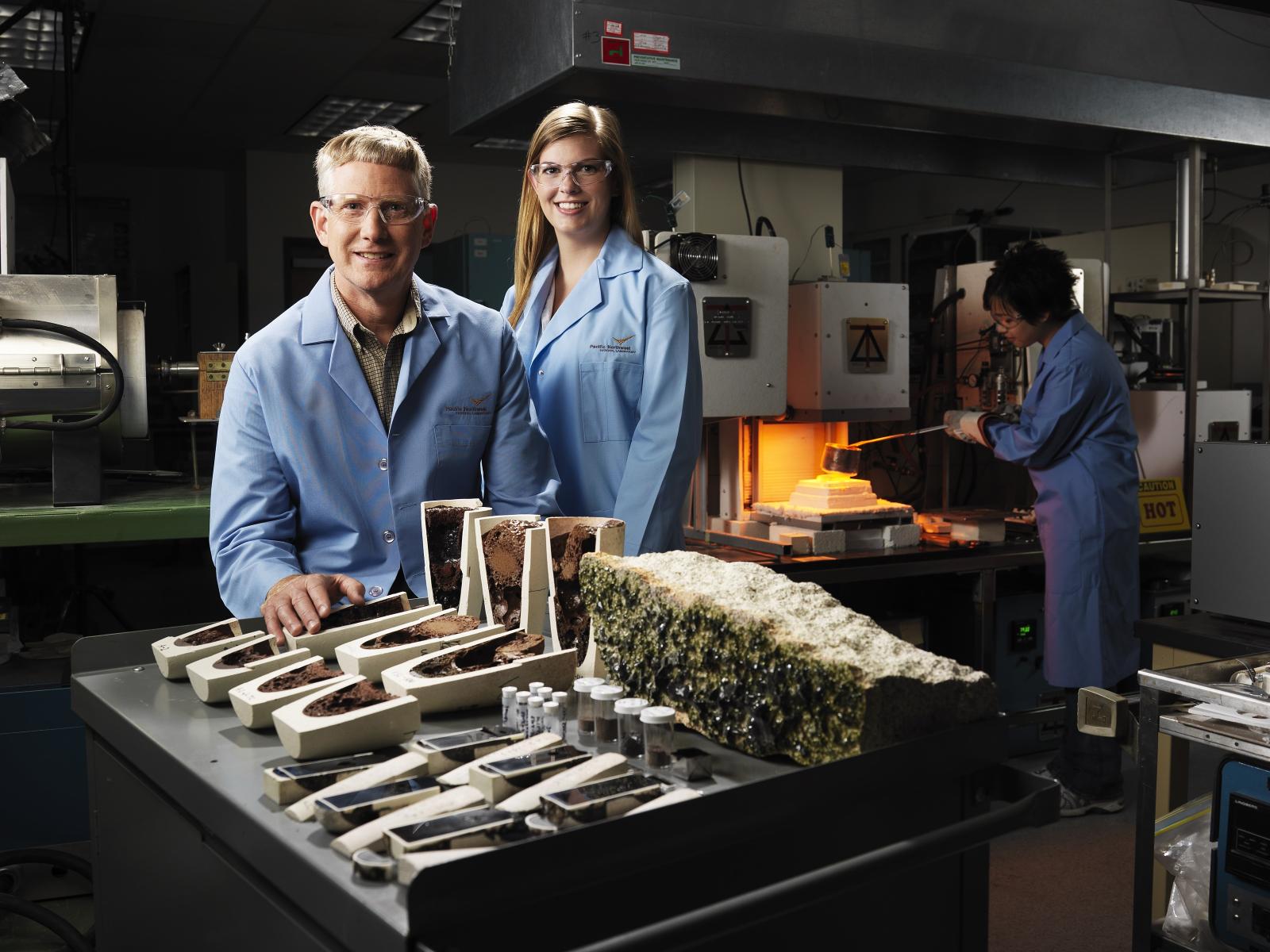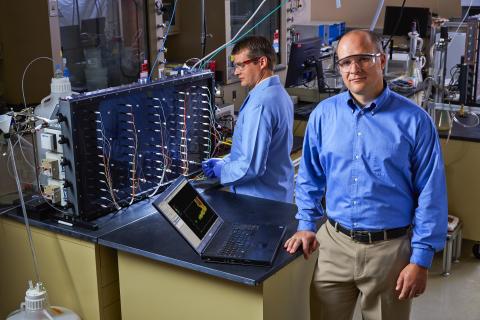Science and Solutions for Environmental Remediation at PNNL

Researcher Mike Schweiger works in PNNL's state-of-the-art glass lab, where he and his colleagues analyze the performance of glass used in waste treatment and provide new glass formulations that could improve how much waste can be stored in each canister.
(Photo by Pacific Northwest National Laboratory)
As a Department of Energy national laboratory, Pacific Northwest National Laboratory takes pride in advancing scientific frontiers and developing solutions to vexing problems. In particular, we apply our technical expertise to address national needs in security, energy and the environment.
Our support of DOE's environmental management mission is a great example. By combining scientific understanding with applied engineering, we are helping to remediate the environmental legacy resulting from seven decades of nuclear energy research and weapons development.
PNNL has supported the Hanford site mission for more than 50 years. Through our efforts, we have developed a deeper and broader knowledge of Hanford than any other research institution. Moreover, since we live here, we have a keen interest in ensuring that Hanford is cleaned up quickly, completely and safely—and that we protect the environment, especially our beautiful Columbia River, in the process.
Of course, Hanford is only one of 16 contaminated sites in 11 states that DOE is responsible for cleaning up. Our understanding of DOE's environmental management challenges has positioned us to assist cleanup efforts across the DOE complex. PNNL has been a leader in developing subsurface and chemical engineering processes that are the basis for cleanup at Hanford, Savannah River, West Valley and many others.

We partner with other national laboratories and contractors to develop innovative, science-based solutions. We focus on those complex challenges that have impeded progress in waste processing and environmental remediation and increased life-cycle costs for long-term stewardship. Our scientists strive to understand and predict how systems will perform, whether they are systems for managing and monitoring residual tank waste; waste processing, immobilization and disposal; or environmental remediation, restoration and stewardship. Our scientific analyses and technical assessments also inform decision-makers' evaluations of options and risk.
In the late 1970s, PNNL developed vitrification technologies to encapsulate high-level nuclear waste in a stable glass form for safe and long-term disposal. Today, we work in our state-of-the-art glass laboratory to advance that research and provide new glass formulations and alternative processing approaches. The goal is to significantly improve the amount of waste that can be stored in each canister while meeting various performance constraints. Developing glasses that are more tolerant to key waste components not only provides a technical basis for increasing how much waste they can hold—which ultimately reduces the number of canisters needed, but also provides opportunities to minimize or eliminate certain pretreatment options. This integrated program is reducing the time the Waste Treatment Plant will need to operate, thus decreasing the cost.
We focus on complex challenges that have impeded progress in waste processing and environmental remediation and increased life-cycle costs for long-term stewardship.
PNNL also provides expertise to help monitor the site. We partnered with Hanford more than 50 years ago to establish the environmental monitoring programs that protect our critical water resources. And our capabilities have come a long way since then. Today, we are developing and applying technologies that allow us to "see" contamination in the subsurface. By comparing images over time, our scientists are constructing three-dimensional, time-lapse movies of contaminant transport in the environment. We can also see, in near real-time, how remediation processes are working and whether they are successfully keeping subsurface contaminants from reaching water resources.
Taking a step toward remediating these contaminants, PNNL researchers recently completed a draft technology evaluation plan for iodine-129 in the Hanford Site soil and groundwater. Iodine-129 is a contaminant of concern because of its long half-life, high mobility in groundwater and long-term risk to human health and the environment. The plan outlines an approach to evaluate technologies for remediating iodine-129 contamination in the subsurface. It is being implemented in collaboration with the site contractor, CH2M.
Similarly, PNNL researchers and collaborators from the University of Cincinnati and Florida State University are drawing on the computational and experimental resources at the Environmental Molecular Sciences Laboratory (a DOE user facility at PNNL) to demonstrate a new field-deployable sensor that can be used to monitor groundwater, river water and watersheds for pertechnetate, another contaminant of concern.
We partnered with Hanford more than 50 years ago to establish the environmental monitoring programs that protect our critical water resources
The team's novel approach overcomes limitations of existing technologies. By using highly selective and sensitive platinum salt that changes in color and brightness when exposed to pertechnetate, it is much easier to detect and quantify pertechnetate in groundwater—even at levels well below the drinking water standard established by the Environmental Protection Agency.
These are just a few of the ways in which PNNL is helping DOE to meet its commitment to clean up Hanford and other sites. By resolving critical technical issues, maturing new technologies, and conducting basic research, PNNL is developing solutions, reducing costs and lowering risks associated with the environmental remediation of former nuclear production sites. Although this effort may take decades, you can count on PNNL to be there for our community and the nation.
Steven Ashby, director of Pacific Northwest National Laboratory, writes this column monthly. To read previous Director's Columns, visit pnnl.gov/news and filter by Director's Columns in our Latest Stories.
Published: March 13, 2016